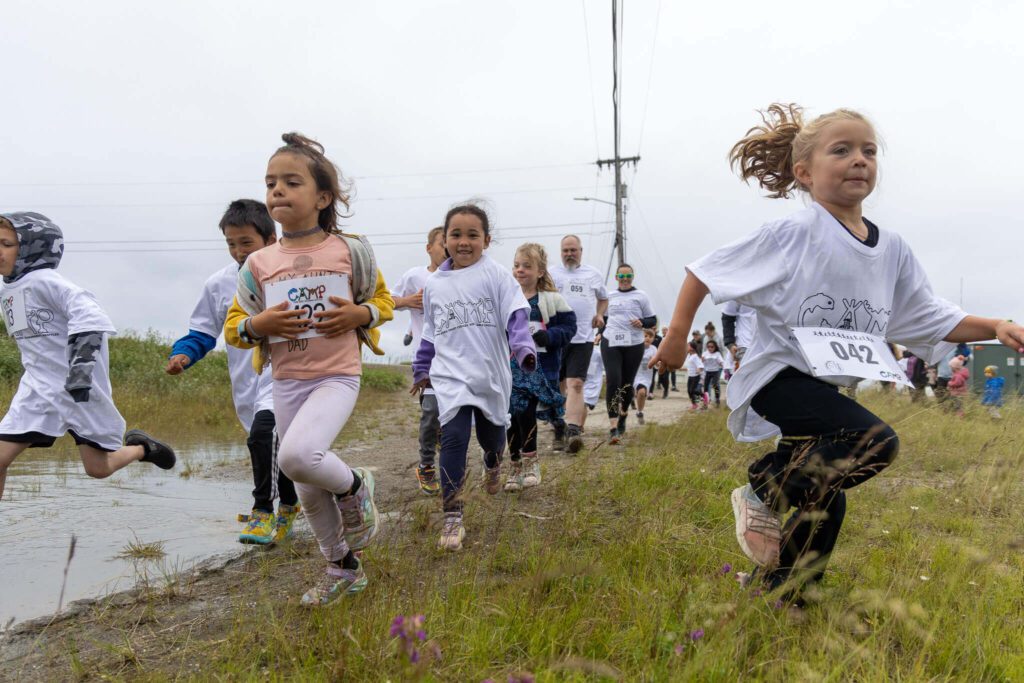Never in Iditarod history have as many teams finished the 1,000-mile race in under nine days, but this year, eight of the top ten teams did just that. Some of the mushers who crossed the finish line faced enormous adversity on their way to Nome. But without any major weather events, most of the mushing that took place was simply the fastest in the race’s history.
It took exactly nine days and 46 seconds for four-time champion Jeff King to complete this year’s Iditarod. King has finished the race 26 times, but this year’s was certainly his fastest.
“I was wondering if it’s going to be a seven day race someday. Surely, it’s probably possible, and more power to anyone who can do it well.”
When King first ran the race in 1981, it took him over 15 days.
This year, he was running within a half-hour of two fierce competitors: a Norwegian world champion, Ralph Johannessen, and Frenchman Nic Petit. For the second year in a row, King stood under the Burled Arch and claimed he wasn’t racing as hard as he has in previous years.
“I think the old Jeff King would have caught both those guys in front of me, but it was too much work going over the cape.”
King simply didn’t want to run behind his team for miles.
Emotionally, this may have been one of the toughest races of King’s career. Five days in, a drunk snowmachine driver plowed into his team while he was travelling down the Yukon River. One of his dogs was killed. Three others were injured.
“Quite frankly, the snowmachine that hit us went by so fast, I don’t think the dogs really realized what happened. It was more of an absolute blur, from which only the ones who were impacted really realized what happened.”
King decided to proceed with the race, in part to avoid the media frenzy that ensued following the incident.
“It’s real easy to imagine and recognize what a bummer that night was on the trail, but the fact is it could have been so, so much worse.”
But, he says, the incident certainly changed his race.
“Basically, I had to leave 25% of my dogs, and I had less options, performance-wise.”
Even so, King managed to pull off a top-ten finish and a personal best — in fact, his race time is one that would have won the race five times in the last decade.
“It was really hard this year, it was really hard.”

Aliy Zirkle also had a run-in with the same snowmachine on the Yukon River. The experience had a serious impact on her, both emotionally and mentally. For the rest of the race, she tried to maintain her cool, but avoided media attention and kept to herself outside checkpoints.
“Everyone goes through hard times in their life, and I guess I count on myself and my dogs.”
But she managed to pull off a third-place finish and her second best run time — eight days, eighteen hours, and 46 minutes.
“And then Alaska, like, talked back, and people were so supportive, and I couldn’t just be with myself, it turned out I was with everyone — and that’s probably what a person ought to do, anyway.”

“You been running all the way?”
After father-son duo Mitch and Dallas Seavey finished in the top two positions this year, they joked with each other about how fast they had to move to get to Nome.
DS: “Six got here faster than any dogs ever have?”
MS: “You got the record?”
DS: “Yeah!”
This year, Dallas Seavey beat the race record — one he set himself — by two hours, completing the 1,000-mile journey in eight days, eleven hours, and 22 minutes. Mitch Seavey also achieved a new personal best time.
“I thought we were gonna be within half an hour for it,” Dallas says.
The older Seavey says his son will remain hard to beat, because Dallas Seavey is so focused on perfecting how he rests his dogs to maintain long-term speed as they move down the trail.
“Dallas is a little ahead of me on the trailer technology and carrying dogs, and he’s willing to put more work into that than I am in carrying dogs and the rest schedule and all of that.”

It seems that most of the teams, even in the top 20, were able to surge toward Nome at top speed. After Brent Sass’s team refused to leave the White Mountain checkpoint, he was forced to rest his team for nearly a full day.
“I knew I was on the edge, but I came to play the game, and we poured it all out on the field and gave it all we could — and came up a little short.”
His run time would have put him in third place three years ago.
This year’s race trail was a hard-packed combination of ice and snow and, in places, bare dirt. When he pulled across the finish line in eighth place, Norwegian Ralph Johannessen seemed surprised at the lack of severe weather and extreme cold.
“No problem with weather and sunshine mostly every day, no wind, no snow, so it was a good race.”
Without the challenges Mother Nature usually throws at the race, mushers could simply do what they do best: drive dog teams. A combination of high-quality dog care, mental toughness, and resiliency brought many mushers to Nome in record time.
And if they watched closely, spectators got a rare glimpse into the technical skills and savvy strategizing that plays out during a long-distance sled-dog race.
https://www.instagram.com/p/BC_JnOLwam7/
https://www.instagram.com/p/BC_V8Mowah4/
https://www.instagram.com/p/BDBs0Cjwaso/
https://www.instagram.com/p/BDCOMxnwatq/







